Triangle conic
In Euclidean geometry, a triangle conic is a conic in the plane of the reference triangle and associated with it in some way. For example, the circumcircle and the incircle of the reference triangle are triangle conics. Other examples are the Steiner ellipse, which is an ellipse passing through the vertices and having its centre at the centroid of the reference triangle; the Kiepert hyperbola which is a conic passing through the vertices, the centroid and the orthocentre of the reference triangle; and the Artzt parabolas, which are parabolas touching two sidelines of the reference triangle at vertices of the triangle.
The terminology of triangle conic is widely used in the literature without a formal definition; that is, without precisely formulating the relations a conic should have with the reference triangle so as to qualify it to be called a triangle conic (see [1][2][3][4]). However, Greek mathematician Paris Pamfilos defines a triangle conic as a "conic circumscribing a triangle △ABC (that is, passing through its vertices) or inscribed in a triangle (that is, tangent to its side-lines)".[5][6] The terminology triangle circle (respectively, ellipse, hyperbola, parabola) is used to denote a circle (respectively, ellipse, hyperbola, parabola) associated with the reference triangle is some way.
Even though several triangle conics have been studied individually, there is no comprehensive encyclopedia or catalogue of triangle conics similar to Clark Kimberling's Encyclopedia of Triangle Centres or Bernard Gibert's Catalogue of Triangle Cubics.[7]
Equations of triangle conics in trilinear coordinates
The equation of a general triangle conic in trilinear coordinates x : y : z has the form
The equations of triangle circumconics and inconics have respectively the forms
Special triangle conics
In the following, a few typical special triangle conics are discussed. In the descriptions, the standard notations are used: the reference triangle is always denoted by △ABC. The angles at the vertices A, B, C are denoted by A, B, C and the lengths of the sides opposite to the vertices A, B, C are respectively a, b, c. The equations of the conics are given in the trilinear coordinates x : y : z. The conics are selected as illustrative of the several different ways in which a conic could be associated with a triangle.
Triangle circles
| No. | Name | Definition | Equation | Figure |
|---|---|---|---|---|
| 1 | Circumcircle | Circle which passes through the vertices | 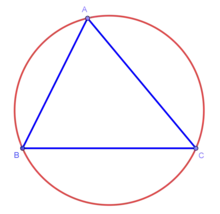 Circumcircle of △ABC | |
| 2 | Incircle | Circle which touches the sidelines internally | 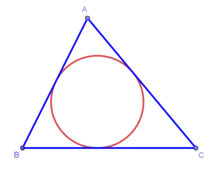 Incircle of △ABC | |
| 3 | Excircles (or escribed circles) | A circle lying outside the triangle, tangent to one of its sides and tangent to the extensions of the other two. Every triangle has three distinct excircles. |
 Incircle and excircles | |
| 4 | Nine-point circle (or Feuerbach's circle, Euler's circle, Terquem's circle) | Circle passing through the midpoint of the sides, the foot of altitudes and the midpoints of the line segments from each vertex to the orthocenter |  The nine points | |
| 5 | Lemoine circle | Draw lines through the Lemoine point (symmedian point) K and parallel to the sides of triangle △ABC. The points where the lines intersect the sides lie on a circle known as the Lemoine circle. |  Lemoine circle of triangle ABC |
Triangle ellipses
| No. | Name | Definition | Equation | Figure |
|---|---|---|---|---|
| 1 | Steiner ellipse | Conic passing through the vertices of △ABC and having centre at the centroid of △ABC | 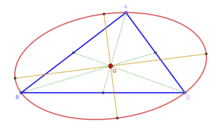 Steiner ellipse of △ABC | |
| 2 | Steiner inellipse | Ellipse touching the sidelines at the midpoints of the sides | 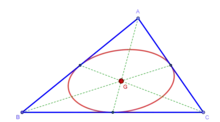 Steiner inellipse of △ABC | |
Triangle hyperbolas
| No. | Name | Definition | Equation | Figure |
|---|---|---|---|---|
| 1 | Kiepert hyperbola | If the three triangles △XBC, △YCA, △ZAB, constructed on the sides of △ABC as bases, are similar, isosceles and similarly situated, then the lines AX, BY, CZ concur at a point N. The locus of N is the Kiepert hyperbola. | 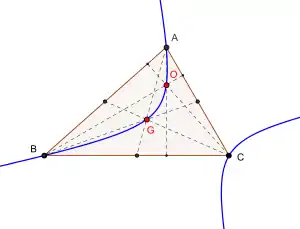 Kiepert hyperbola of △ABC. The hyperbola passes through the vertices A, B, C, the orthocenter (O) and the centroid (G) of the triangle. | |
| 2 | Jerabek hyperbola | The conic which passes through the vertices, the orthocenter and the circumcenter of the triangle of reference is known as the Jerabek hyperbola. It is always a rectangular hyperbola. | 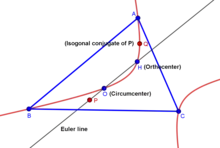 Jerabek hyperbola of △ABC | |
Triangle parabolas
| No. | Name | Definition | Equation | Figure |
|---|---|---|---|---|
| 1 | Artzt parabolas[9] | A parabola which is tangent at B, C to the sides AB, AC and two other similar parabolas. |  Artzt parabolas of △ABC | |
| 2 | Kiepert parabola[10] | Let three similar isosceles triangles △A'BC, △AB'C, △ABC' be constructed on the sides of △ABC. Then the envelope of the axis of perspectivity the triangles △ABC and △A'B'C' is Kiepert's parabola. | 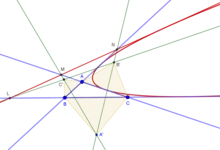 Kiepert parabola of △ABC. The figure also shows a member (line LMN) of the family of lines whose envelope is the Kiepert parabola. | |
Families of triangle conics
Hofstadter ellipses
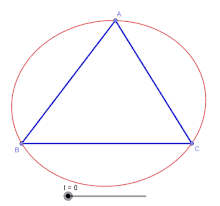
An Hofstadter ellipse[11] is a member of a one-parameter family of ellipses in the plane of △ABC defined by the following equation in trilinear coordinates:
where t is a parameter and
The ellipses corresponding to t and 1 − t are identical. When t = 1/2 we have the inellipse
and when t → 0 we have the circumellipse
Conics of Thomson and Darboux
The family of Thomson conics consists of those conics inscribed in the reference triangle △ABC having the property that the normals at the points of contact with the sidelines are concurrent. The family of Darboux conics contains as members those circumscribed conics of the reference △ABC such that the normals at the vertices of △ABC are concurrent. In both cases the points of concurrency lie on the Darboux cubic.[12][13]

Conics associated with parallel intercepts
Given an arbitrary point in the plane of the reference triangle △ABC, if lines are drawn through P parallel to the sidelines BC, CA, AB intersecting the other sides at Xb, Xc, Yc, Ya, Za, Zb then these six points of intersection lie on a conic. If P is chosen as the symmedian point, the resulting conic is a circle called the Lemoine circle. If the trilinear coordinates of P are u : v : w the equation of the six-point conic is[14]
Yff conics
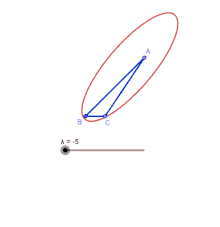
The members of the one-parameter family of conics defined by the equation
where is a parameter, are the Yff conics associated with the reference triangle △ABC.[15] A member of the family is associated with every point P(u : v : w) in the plane by setting
The Yff conic is a parabola if
(say).
It is an ellipse if and and it is a hyperbola if . For , the conics are imaginary.
References
- Paris Pamfilos (2021). "Equilaterals Inscribed in Conics". International Journal of Geometry. 10 (1): 5–24.
- Christopher J Bradley. "Four Triangle Conics". Personal Home Pages. University of BATH. Retrieved 11 November 2021.
- Gotthard Weise (2012). "Generalization and Extension of the Wallace Theorem". Forum Geometricorum. 12: 1–11. Retrieved 12 November 2021.
- Zlatan Magajna. "OK Geometry Plus". OK Geometry Plus. Retrieved 12 November 2021.
- "Geometrikon". Paris Pamfilos home page on Geometry, Philosophy and Programming. Paris Palmfilos. Retrieved 11 November 2021.
- "1. Triangle conics". Paris Pamfilos home page on Geometry, Philosophy and Programming. Paris Palfilos. Retrieved 11 November 2021.
- Bernard Gibert. "Catalogue of Triangle Cubics". Cubics in Triangle Plane. Bernard Gibert. Retrieved 12 November 2021.
- Nelle May Cook (1929). A Triangle and its Circles (PDF). Kansas State Agricultural College. Retrieved 12 November 2021.
- Nikolaos Dergiades (2010). "Conics Tangent at the Vertices to Two Sides of a Triangle". Forum Geometricorum. 10: 41–53.
- R H Eddy and R Fritsch (June 1994). "The Conics of Ludwig Kiepert: A Comprehensive Lesson in the Geometry of the Tr". Mathematics Magazine. 67 (3): 188–205. doi:10.1080/0025570X.1994.11996212.
- Weisstein, Eric W. "Hofstadter Ellipse". athWorld--A Wolfram Web Resource. Wolfram Research. Retrieved 25 November 2021.
- Roscoe Woods (1932). "Some Conics with Names". Proceedings of the Iowa Academy of Science. 39 Volume 50 (Annual Issue).
- "K004 : Darboux cubic". Catalogue of Cubic Curves. Bernard Gibert. Retrieved 26 November 2021.
- Paul Yiu (Summer 2001). Introduction to the Geometry of the Triangle (PDF). p. 137. Retrieved 26 November 2021.
- Clark Kimberling (2008). "Yff Conics". Journal for Geometry and Graphics. 12 (1): 23–34.